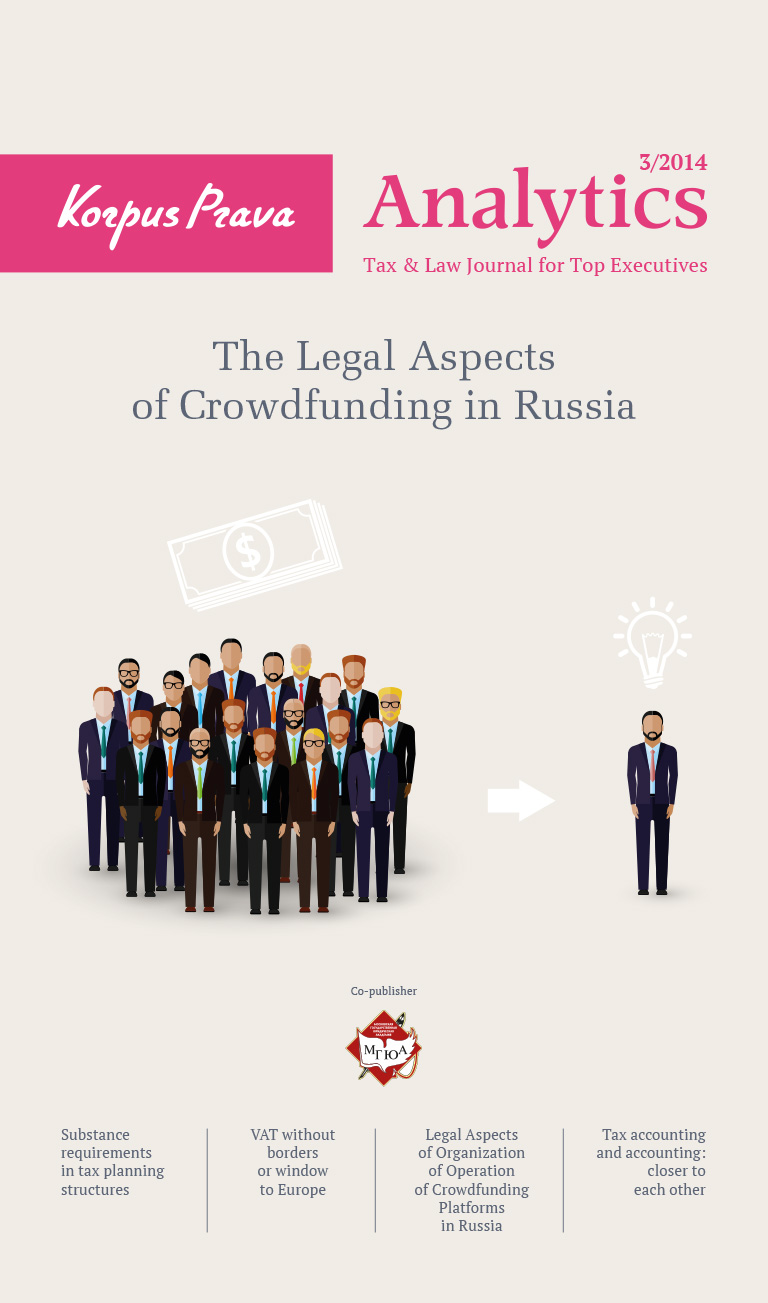- Cyprus Citizenship Scheme for Foreign Investors
- Squeezed But Pleased: Taxation of Passive Income in the European Union
- VAT Without Borders or Window to Europe
- Legal Aspects of Organization of Operation of Crowdfunding Platforms in Russia
- Substance Requirements in Tax Planning Structures
- “Deposit Splitting” of Individuals. Legal Civil and Criminal Aspects
Bringing Hidden Beneficiary to Subsidiary Responsibility
The next stage of development has begun in the Russian Bankruptcy Law: a new chapter III.2 has been introduced into the Bankruptcy Law, which regulates the issues of bringing the debtor’s manager and other controlling persons to subsidiary and other responsibilities. In addition, in order to correctly apply the norms contained in this chapter, Resolution of the Plenum of the Supreme Court of the Russian Federation No. 53 was adopted.
This Resolution of the Plenum has answered many issues raised by the legal community; however, some of them have remained open.
One of these issues is the determination of the status of the person controlling the debtor1.
So, the ability to determine the actions of the debtor by the controlling person can be achieved:
- By virtue of being with the debtor (by director or members of the debtor’s governing bodies) in relation to filiation or property, official position;
- By virtue of the presence of the authority to make transactions on behalf of the debtor, based on a power of attorney, regulatory legal act or other special powers;
- By virtue of official position;
- Otherwise, including by coercing the head or members of the debtor’s governing bodies or exercising a decisive influence on the head or members of the governing bodies of the debtor in another way.
To simplify the proof of the status of the person controlling the debtor in paragraph 4 of Art. 61.10 of the Federal Law of October 26, 2002 No. 127-FZ On Insolvency (Bankruptcy) rebuttable presumptions were established. Until it is proven otherwise, it is considered that the person controlled the debtor, if that person:
- He was the head of the debtor or the managing organization of the debtor, a member of the executive body of the debtor, the liquidator of the debtor, a member of the liquidation commission;
- Had the right, independently or together with interested parties, to dispose of fifty or more percent of the voting shares of the joint-stock company, or more than half of the share capital of the limited (additional) liability company, or more than half of votes in the general meeting of participants of the legal entity, or had the right to appoint (elect) the head of the debtor;
- Benefited from illegal or inequitable conduct of the persons referred to in paragraph 1 of article 53.1 of the Civil Code of the Russian Federation.
If a person does not belong to the governing bodies of the debtor, does not own interest/shares of the debtor, then in practice it is very difficult to prove that he has the status of the person controlling the debtor.
The behavior of the person controlling the debtor can be either open (the beneficiary of the debtor) or closed (hides the impact on the debtor).
In case of open behavior, the status of the person controlling the debtor is easier to prove through the use of testimony, correspondence, and media reports.
So, in the case of bringing S.V. Pugachev to subsidiary responsibility for the obligations of International Industrial Bank, CJSC, the existence of actual control over the debtor was established due to the combination of circumstances:
- The existence of the system of approval and decision-making in the bank, in which, without the consent of S.V. Pugachev could not have made any decision in the bank;
- The existence of the office of S.V. Pugachev at the bank office.
However, such evidence cannot be presented to the court if the person controlling the debtor is hidden. Moreover, there are no criteria in the legislation that allow determining the hidden beneficiary to bring him to subsidiary responsibility.
In this regard, Definition of the Judicial Panel on Economic Disputes of the Supreme Court of the Russian Federation of February 15, 2018 No. 302-ЭС14-1472 (4, 5, 7) in case No. A33-1677/20139, in which the Supreme Court of the Russian Federation, among other things, gave explanations regarding the conduct of the person controlling the debtor and the debtor and signs of control by the hidden controlling person listed below, is of crucial importance for bringing the debtor’s beneficiaries to subsidiary liability in bankruptcy and for applying the piercing corporate veil:
- The actions of these subjects are synchronous in the absence of objective economic reasons;
- Actions are contrary to the economic interests of the debtor and at the same time lead to a significant increase of the property of the person brought to justice;
- These actions could not take place in any other circumstances, except in the presence of subordination of one to the other, etc.
Thus, the aforementioned Definition discloses another presumption of the status of the person controlling the debtor which is benefiting by from illegal or inequitable conduct a person brought to subsidiary responsibility of the economic benefits.
Paragraph 7 of Resolution No. 53 states that a person, who has gained substantial (relative to the scale of the debtor’s activity) benefit in the form of increasing or saving assets, which could not have been formed if the actions of the debtor’s manager were in compliance with the law, including the principle of good faith, can be recognized as the controlling person. In particular, it is assumed that the person controlling the debtor is a third party who received a substantial debtor’s asset (including the chain of consecutive transactions), who left the latter’s possession on the transaction made by the debtor’s head to the detriment of the interests of the organization and its creditors (on consciously unfavorable conditions for the debtor or with a person who is knowingly unable to perform the obligation (by a shadow company, etc.) or with the use of a document flow that does not reflect actual business operations , etc.).
Disproving this presumption of the status of the person controlling the debtor, a person brought to subsidiary liability has the right to prove his good faith by confirming, among other things, the paid acquisition of a debtor’s asset on terms and conditions under which similar transactions are usually made in comparable circumstances.
Also in clause 7 of Resolution No. 53 it is assumed that the controlling person is the beneficiary, taking significant advantages from such a system of business organization, which is aimed at the redistribution (including through inaccurate document flow) of the total income received from the implementation of this activity by persons united by common interest (for example, a single production and (or) sales cycle), in favor of a number of these persons with simultaneous accumulation on the debtor’s side main debt load. In this case, in order to refute the presumption, the beneficiary shall prove that his income-generating operations have been reflected in accordance with their real economic meaning, and the benefits obtained by him are due to reasonable economic reasons.
In addition, the Supreme Court of the Russian Federation determined that in the absence of direct evidence of giving by the controlling person of instructions, the totality of substantial indirect evidence that is based on the analysis of the person controlling the debtor and the debtor’s behavior shall be taken into account by the courts. If the interested persons were able to provide the court with substantial indirect evidence, which together make it possible to recognize convincing arguments about the emergence of a relationship of actual control and subordination, by virtue of art. 65 of Arbitration Procedure Code of the Russian Federation the burden of proof of the reverse shifts to the person brought to justice.
It is hoped that the legal positions reflected in the Definition will push the courts to a more careful study of indirect evidence and the rejection of a formal approach to determining the status of the person controlling the debtor.
- A person controlling the debtor is an individual or legal person who either has or had more than 3 years prior to the occurrence of signs of bankruptcy, as well as after their occurrence prior to the adoption by the arbitral tribunal of an application declaring the debtor bankrupt to give binding instructions to the debtor or otherwise determine actions of the debtor, including the transaction and the determination of conditions.
Your subscription to our journal will definitely boost the efficiency of your specialists and downsize your expenses for consultants.
The journal is available free of charge in the electronic version.
Free Download

